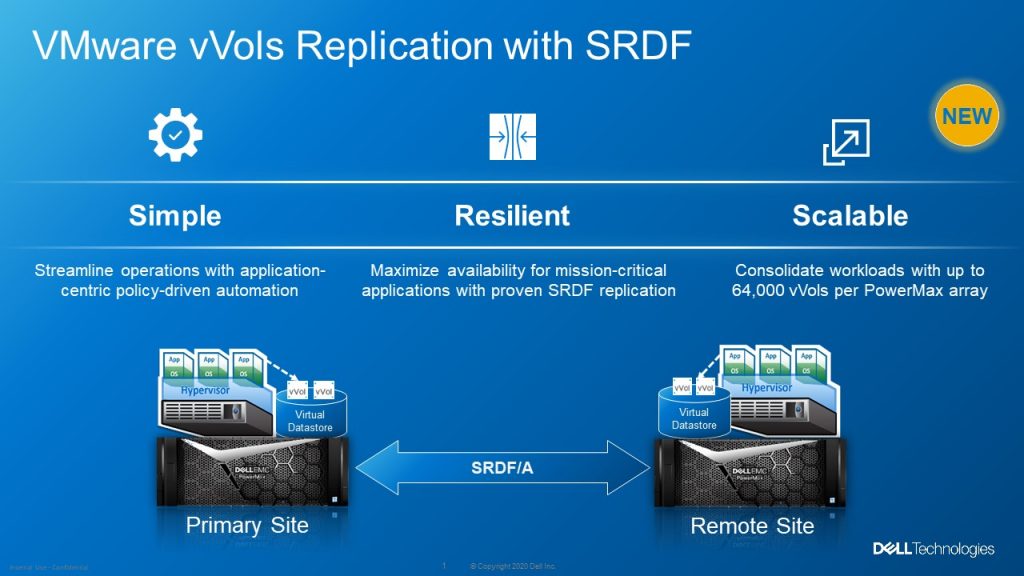Two years ago, Dell Technologies unleashed the world’s fastest storage array, Dell PowerMax, delivering new levels of performance and scalability with the industry’s richest feature-set, helping customers address pressing IT challenges of today and tomorrow. Last year, we were the first vendor to introduce storage class memory as persistent storage.
Today, we push the boundaries of high-end storage further with new PowerMax features and enhancements designed to help simplify the management of mission critical workloads, provide native cloud mobility and deliver even greater security.
VMware and Dell PowerMax Integration: Dell Technologies and VMware combined forces to add mission-critical availability and the highest scalability to VMware Virtual Volumes (vVols). As customers modernize their infrastructure and move from a hardware-centric storage approach to an application-centric approach for managing storage with VMware vVols, Dell is delivering the world’s fastest storage array1, PowerMax, for running virtual volumes at scale (64,000 vVols) with the highest levels of data resiliency.
Today, we are announcing that customers can deploy VMware Site Recovery Manager (SRM 8.3) for vVols with PowerMax SRDF/A replication for automated VM movement between sites to ensure maximum availability for mission-critical applications. VMware vVols incorporates storage policy-based management (SPBM) to significantly simplify both storage and VM administration in provisioning storage, establishing replication groups, and automating site recovery operations in the event of a system failover.
Combining PowerMax SRDF, the gold standard in remote replication, with VMware’s storage capabilities accelerates the IT modernization journey for our customers and delivers on the promise of simple, resilient, scalable storage.
Cloud Mobility for Dell PowerMax
Dell’s storage systems easily extend to the cloud to address rapid data growth and to optimize data center resources with simple and efficient data mobility to and from public and hybrid clouds. Today’s announcement, Cloud Mobility for Dell PowerMax, offers seamless and transparent movement of data from on-premises to cloud, enabling PowerMax customers to leverage lower cost object storage in cloud for agile and economic benefits, reducing the cost per GB for long-term data retention by up to 50%2.
“Using Cloud Mobility for Dell PowerMax will help our organization optimize storage resources with on-premises high performance workloads, while leveraging private cloud for long-term retention in a way that meets our compliance requirements”, said Thorsten Tüllmann, Systems Engineer, KIT.
Archiving and long-term retention are primary examples of how PowerMax customers can leverage Amazon Web Services (AWS), Microsoft Azure, or Dell ECS for low-cost object storage. PowerMax data can be recovered back to the source PowerMax if needed. In addition to the economic benefit, archiving to the cloud frees up capacity for on-premises PowerMax arrays to support higher priority applications on-premises — extending the useful life of PowerMax.
PowerMax data stored in the cloud can also be made available to an AWS system for secondary processing such as reporting, test/development, and data analytics. Customers can deploy the Dell vApp free of charge from the Amazon Marketplace to transfer PowerMax snapshot data from Amazon S3 object storage to Amazon elastic block storage (EBS).
PowerMax Smart DR Sets New Standard for Data Resiliency
Dell continues to raise the bar for delivering the industry’s highest availability storage systems. The latest PowerMax innovation extends SRDF/Metro active/active replication by adding Smart DR (disaster recovery) for unmatched data resiliency combined with increased efficiency.
Smart DR copies data from both primary arrays to one remote array to maintain data resiliency (DR operations) even if one primary array becomes unavailable. Copying the data to one remote array saves 50% of storage capacity while reducing the SRDF/A network bandwidth needs³, helping customers realize data resiliency and efficiency from their SRDF/Metro Smart DR investment.
Unmatched Security Safeguards Customer Data
New PowerMax security features deliver on the goal of safeguarding mission-critical customer data from unwanted intrusion or cyberattacks. PowerMax end-to-end efficient encryption enables customers to secure storage assets by encrypting data from the host to the storage media on PowerMax. Dell Technologies has partnered with Thales Inc., a leading security firm, to integrate host-based encryption and PowerMax data reduction technology to secure PowerMax data while customers receive 3.5:1 data reduction, guaranteed.
“An organization’s most valuable and demanding application data needs robust security without compromising efficiency,” said Charles Goldberg, VP Encryption Product Marketing at Thales. “The latest version of Vormetric Transparent Encryption software from Thales enables security without impacting Dell’s industry-leading storage efficiency techniques. No other file-level encryption solution can accomplish these significant savings on PowerMax.”
In addition, PowerMax has been through Cybersecurity STIG hardening that is required to get on the U.S. Department of Defense (DoD) Approved Products List (APL). Both Federal agencies and non-Federal customers around the world will benefit from PowerMax security hardening.
These latest security enhancements, when combined with existing security features such as secure snapshots, tamper-proof audit logs, secure access controls, assures customers that their data is safe with PowerMax.
Flexible Consumption with Dell Technologies On Demand
With Dell Technologies On Demand, PowerMax customers can respond to workload spikes and new service requests with elastic capacity and cloud economics. Several payment solutions with short-and-long term commitment options are available, including a one-year term for flexible consumption.
Availability
Dell PowerMax and today’s featured announcements are now generally available globally.
Additional resources
- Visit this webpage for more information: Dell PowerMax
- Connect with Dell via Twitter, Facebook, YouTube and LinkedIn
- Dell Technologies Press Release for VMWorld 2020
- PowerMax vVols SRM 8.3 integration blog on Virtual Blocks
- Dell storage with VMware blog for VMworld 2020
¹ Based on Dell internal analysis of max bandwidth (64K blocks) of the PowerMax 8000 (350GB/s) versus max bandwidth of competitive mainstream arrays, August 2020. Actual performance will vary.
² Based on Dell internal analysis, June 2020. Savings calculated comparing the cost of storing 6 months of Snaps (on avg. 55% capacity consumed) over 3 years on PowerMax 8000 for 1246TB vs. using Cloud Mobility to store snaps in the AWS Public Cloud on Amazon S3 Standard storage. Costs in US dollars. Actual savings will vary.
³ Based on Dell internal analysis, comparing capacity and network bandwidth for PowerMax SRDF/Metro redundant systems with full DR protection vs. PowerMax SRDF/Metro Smart DR redundant systems with full DR protection. Actual savings may vary. August 2020.




